The Fairest of Them All
The Discrete Charm of the Gilera Saturno
Legend Bike magazine article from the November 1992 issue, edited and published in Milan, Italy. Reprinted with permission.
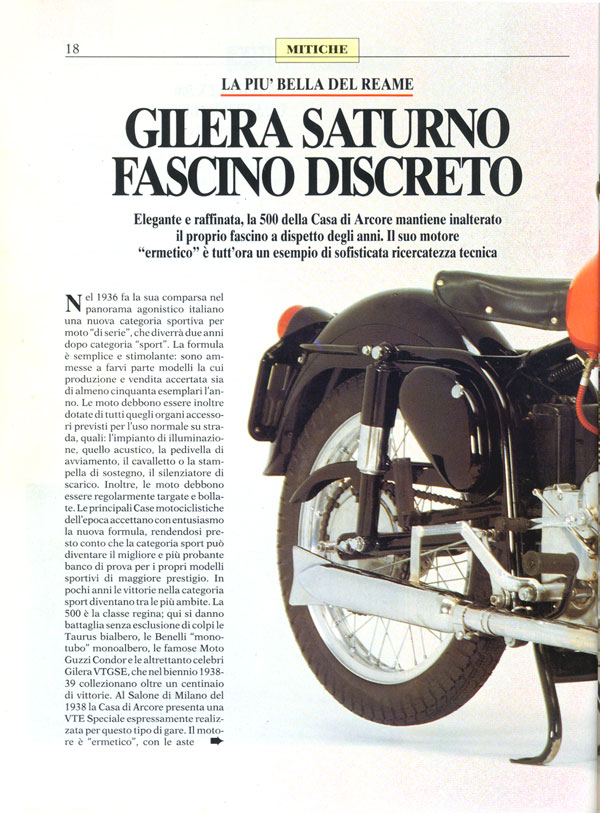
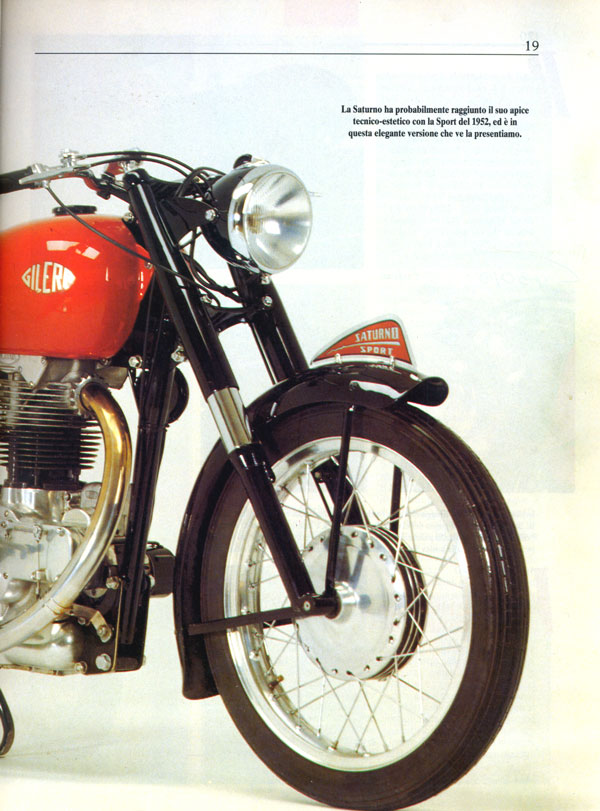
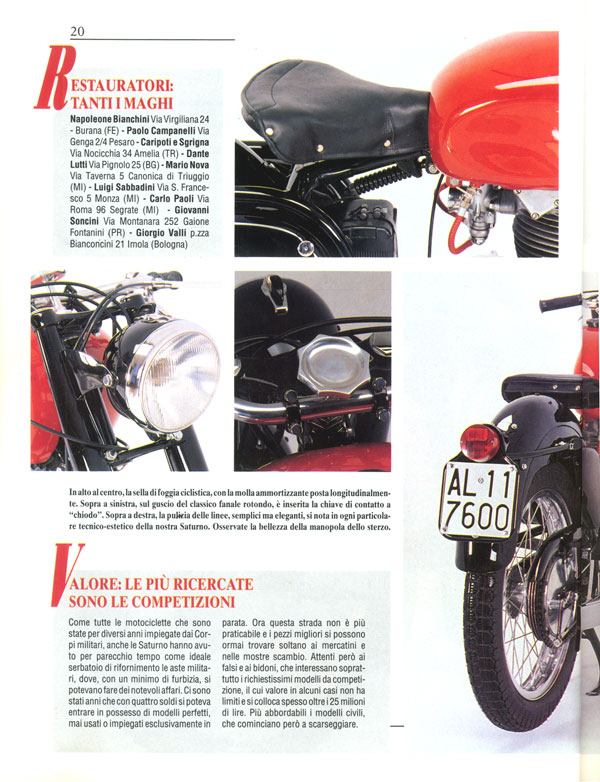
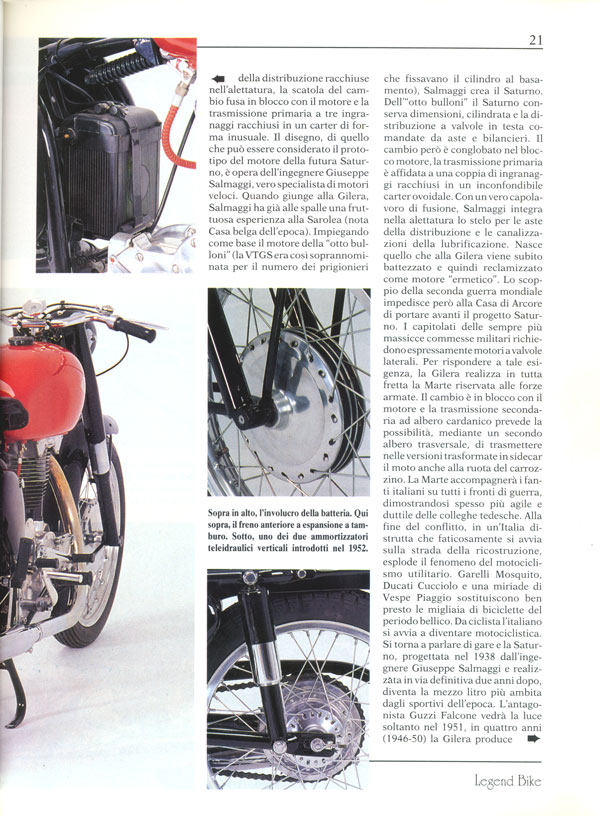
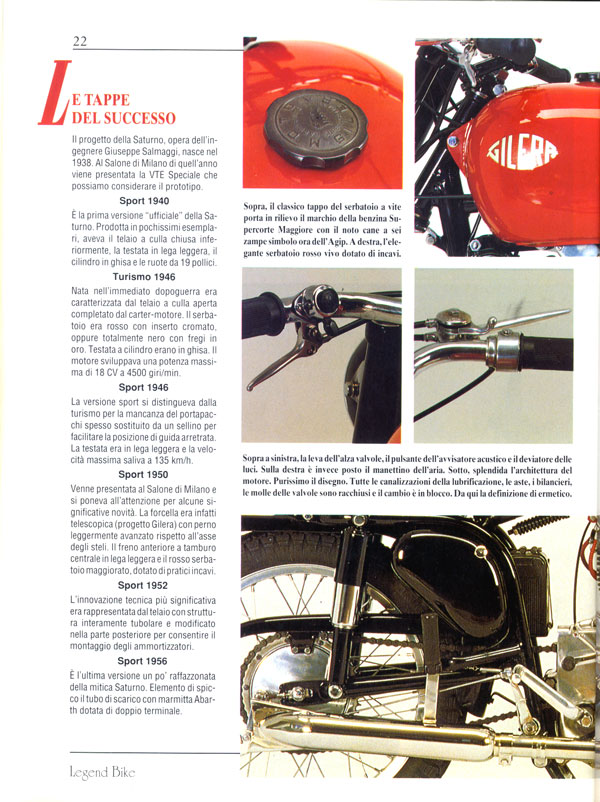
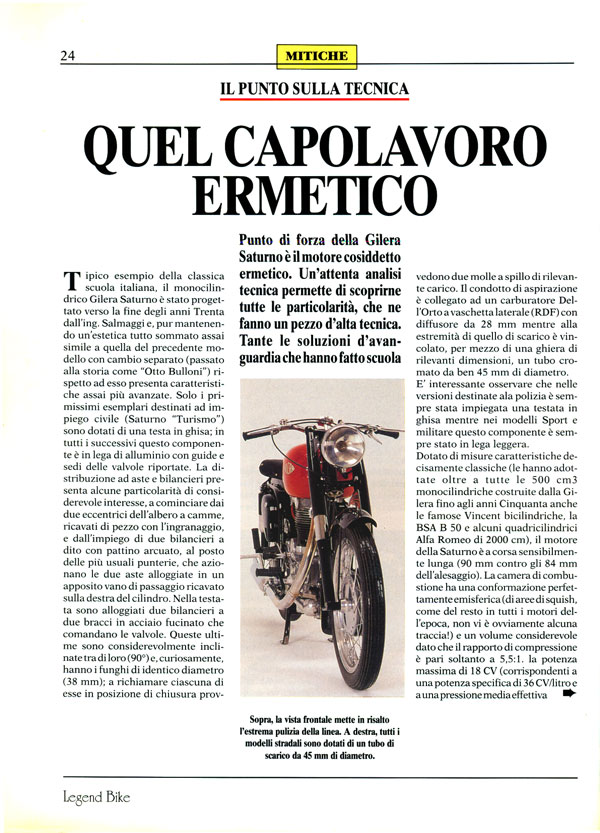
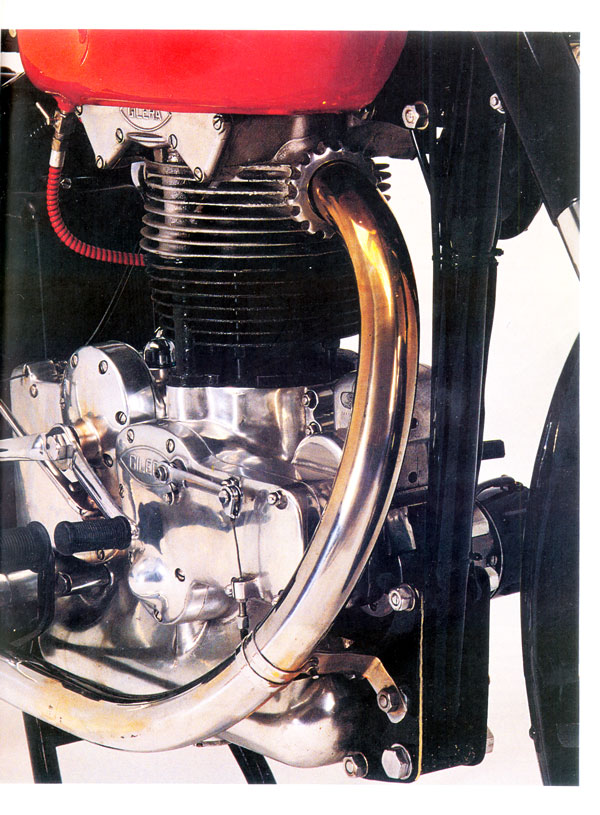
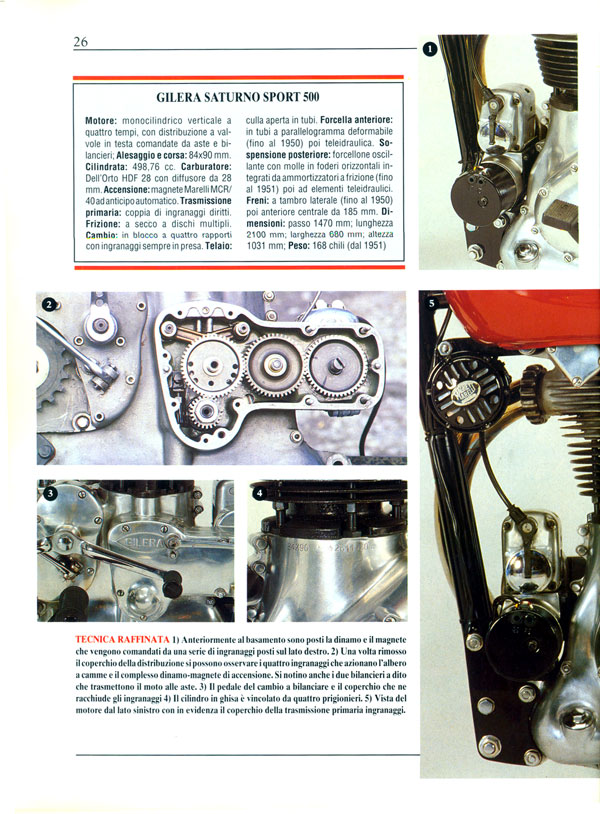
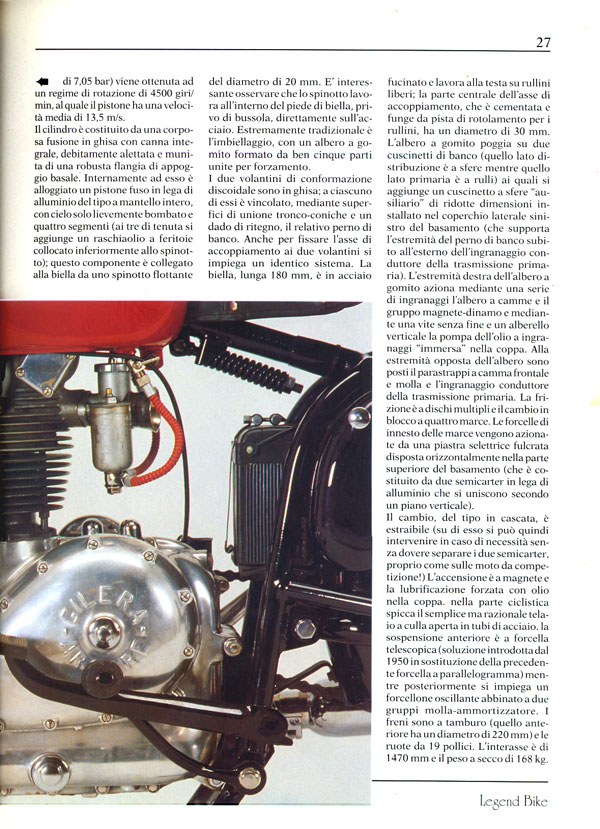
500 cc. GILERA SATURNO SINGLE
ELEGANT AND REFINED, THE 500 FROM ARCORE
MAINTAINS ITS CHARM DESPITE THE PASSING OF TIME
ITS UNIT CONSTRUCTION ENGINE TO THIS DAY IS
AN EXAMPLE
OF MUCH SOUGHT AFTER TECHNICAL
SOPHISTICATION
In 1936, a period of declining Italian motorcycle activity, a new sport category of motorcycle is created (Clubman). The formula is simple: models are allowed to compete if at last fifty units per year are produced and sold. The motorbikes must be produced with all the necessary parts and accessories for normal street use, such as complete electrical system with battery; lights, horn, a centerstand or sidestand and an exhaust muffler.
In addition, the motorbikes must be able to be registered and licensed. The main motorcycle producing factories at the time accepted the new formula with enthusiasm, quickly realizing that the sport category could turn out to be the best marketing promotion of their most prestigious sporting models. In a few year’s victories in the sport category turned out to have the largest marketing sphere of influence.
The 500 class is the flagship category. Battles take place here with the twin cam Taurus, the single cylinder single cam Benellis, the famous Moto Guzzi Condor and the much-celebrated Gilera VTGSE, which in the period of 1938-39 collected over one hundred victories.
At the Exhibition of Milan in 1938, the Arcore Gilera factory presented a Special VTE expressly developed for these types of races. The unit engine is totally enclosed with the distribution pushrods hidden within the cylinder finning, the gearbox and the engine are in one piece and the three gear primary transmission is enclosed in an unusually shaped engine case.
The design of this unit can be considered the prototype of the engine of the future Saturno. This creation is attributed to the engineer Giuseppe Salmaggi, a true specialist of fast engines. When he joined Gilera, Salmaggi already had considerable experience under his belt from Sarolea (a renowned Belgian motorcycle factory of the period).
Utilizing the engine of the “eight bolts” as a base (the VTGS was so called due to the number of studs that joined the cylinder to the cases), Salmaggi designs the Saturno. The new engine keeps the dimensions from the “eight bolts”, the bore and stroke and the distribution with the over-head valves actuated by pushrods and rockers. The gearbox, however, becomes part of the engine block, the primary transmission consisting of a pair of enclosed gears in an unmistakable egg-shaped engine case.
With a true stroke of genius, Salmaggi integrates the canalization necessary for the lubrication of the head inside the passage for the pushrods. This gives birth of a new term and the Gilera Saturno is quickly baptized and thereafter advertised as a “sealed” (hermetic) engine.
The start of World War II however, impedes the Arcore factory in bringing forth the development of the Saturno. All the branches of the military establishment specifically require engines with lateral valves. To meet such challenge, Gilera quickly develops the Marte reserved for the armed forces.
The gearbox comes in a unit with the engine and a driveshaft. Foreseeing other applications, a secondary transmission is designed with a transversal driveshaft to transmit power to the third wheel of a sidecar.
The Gilera “Marte” will accompany the Italian infantry to all the war fronts, often showing themselves to be more agile and responsive, often bettering their German counterparts.
At the end of hostilities, Italy was in shambles and during the reconstruction effort the phenomenon of the utility motorcycle exploded. Garelli Mosquito, Ducati Cucciolo, Lambrettas and Piaggio Vespas quickly increased their production to satisfy the demand for motorized transportation to replace the millions of bicycles used up to that time. From bicyclists, Italians became motorcyclists.
Gilera restarted fabricating the Saturno, originally designed in 1938 by the engineer Giuseppe Salmaggi and completed two years later, soon the half-liter becomes, the most sought after motorcycle by the sporting privateer racers of the time.
Its antagonist, the Guzzi Falcone will not see the light of day until 1950. In the four years period of 1946 to 1950, Gilera produces over 5000 units of the Saturno in the Tourismo and Sport versions. This was a truly considerable number at a time when not many could afford the luxury to purchase such a motorcycle.
The patented rear suspension is unique, whereby the spring coils are placed horizontally in a tube which is the continuation of the rear frame,
The friction dampers are attached between the lower rear fork and the end of the tubes containing the suspension springs. The rear fender is also attached to these tubes.
At the front, girder forks will continue until late 1950, when a slightly leading hydraulic telescopic fork designed by Gilera will replace them in 1951, the front side brake will be replaced by a full central aluminum hub.
In 1952 the frame becomes completely tubular and the classic rear suspension system is adopted using standard hydraulic shock absorbers, the oil sump capacity is increased from 2 to 2.5 liters to improve lubrication. The maximum velocity is reduced to increase dependability and to prevent over stressing the engine distribution.
We have chosen just such version to illustrate the legendary Saturno.
The photographed unit is a Sport version from 1953 and represents in a certain sense, the apex of elegance and simplicity during the evolution of the long career of the Saturno.
In 1956, the Saturno is again revised and modified. Ignition is now by magneto with automatic spark advance and the exhaust is a single Abarth with an expansion chamber followed by the muffler.
This period becomes the swan song for the glorious single from Arcore as it finally ceases production a couple of years later thus beginning the start of a legend.
Epic rival of the Guzzi Falcone, the Saturno, counted on its excellent acceleration, coupled with a very precise and light gear change to beat the competition.
On long distances, however, the distribution was not as dependable which allowed Guzzi to have the upper hand. Yet the Saturno took its revenge on the fast curves where its excellent handling was a real advantage.
Starting was fast and simple; if the tuning was correct there was no need to use the compression release valve. Its exhaust and mechanical noise were considerable. During takeoffs from standing it was advisable not to ride the clutch because it grabbed easily; too bad since the robust gearbox, quick and precise permitted admirable takeoffs.
Maximum velocity was on par with the competition, 135 Km/h. The Saturno was also available in competition garb and renamed Sanremo in memory of its first winning appearance on the Ligurian racetrack. The Sanremo, light, easy to handle, and with excellent braking soon became the King of the most tortuous and concentration-requiring racetracks. But this is another story that merits its own exclusive space in one of the future issues of Legend Bike.
In conclusion, the Tourismo and Sport version of the Saturno can be said to have been a part of the story of the golden years of the Italian motorcycle industry. This is where engineer’s creativity was challenged by a seemingly inexhaustible supply of new ideas for motorcycle improvements. Solution of a very high technical level were implemented, a fine example is the unforgettable Gilera Saturno.
Eugenio Piazza
PARTS & MOTORCYCLE SOURCES:
Of all the motorcycles that have been used by various military branches, the Military Saturno was the most sought after model at Military auctions.
There used to be a time when, with little money, it was possible to acquire motorcycles in perfect condition, never used or used exclusively in parades. This ideal source is no longer available and replacement parts can usually found at vintage bike swap meets and jumbles. Be weary however, of shady vendors that will have no compunction to rip people off, especially with the competition parts of motorcycles whose prices have soared. The civilian versions are more affordable but are becoming hard to find.
THE STAGES OF EVOLUTION OF THE GILERA SATURNO
The Saturno, invented by the engineer Giuseppe Salmaggi, was introduced in 1938. At the Milan Exposition of that year, the VTE Speciale displayed is considered the first prototype.
Sport 1940
It’s the first “official” version of the Saturno. Produced in very few units, it had a frame running under the bottom of the engine; the head is aluminum, the cylinder in cast iron. The wheels are 19 inches in diameter.
Turismo 1946
Born right after the end of the war, it was distinguishable by the open frame below the (stressed) engine. The gasoline tank was red with chromed inserts or completely black with gold pinstriping. Head and cylinder were in cast iron. The engine was capable of developing a maximum of 18 horsepower at 4500 RPM.
Sport 1946
The Sport version was distinguishable from the Turismo by the lack of a luggage rack substituted by a small seat to facilitate crouching. The engine head was aluminum and maximum velocity reached was 135 km/h.
Sport 1950
It was introduced at the Milano Exposition and some significant novelties made it stand out. The forks were now telescopic (a Gilera in house development) with a 19mm leading front axle when measured from the sliders axis. The new full central hub front drum brake is cast in aluminum and the bulbous red gasoline tank with larger capacity now sports new knee indentations.
Sport 1952
The most important technical innovation was that the frame was constructed completely with tubular members and modified in the rear to accept hydraulic shock absorbers.
Sport 1956
It’s the last version and a bit botched from the classical Saturno. Standing out is the single Abarth muffler featuring header pipe with sharper bends. The muffler of questionable shape has two strange looking exhaust tubes at the very rear of it.
The most notable characteristic of the Gilera Saturno is the so named sealed or “hermetic” motor. A careful technical analysis of its details will discover outstanding examples of technical development. Ahead of its time, as a flattery its many technical solutions have been readily copied.
Engineer Salmaggi developed a typical example of the classic Italian school, the single cylinder Gilera Saturno during the late 1930’s. Even though maintaining a design, at first glance, similar to its predecessor featuring a separate gearbox (which passed onto history as the ‘Eight Bolt”), it presented some very advanced characteristics such as a massive unit construction.
The first units destined for civilian use (Saturno “Turismo”) were built with a cast iron head; thereafter this component was changed to aluminum alloy for the sport version, where the valve seats and the valve guides are press fitted into the aluminum.
The distribution by pushrods actuated by rockers presents some particularities of considerable interest, beginning with the two camshaft lobes built in one piece with the driving gear.
The distribution uses two hinged cam followers with smooth arched surfaces that actuate the two pushrods passing inside a cavity within the cylinder fins.
On the top of the head two forged rocker arms actuate the valves. The two valves are inclined towards each other at a 70-degree angle and, curiously, have identical diameters of 38 mm.
Closing each valve are two strong hairpin springs facing each other. The intake port is fitted with a 28 mm Dell’Orto RDF28 carburetor with attached float chamber. The chromed exhaust pipe as a diameter of 45 mm, it is held in place to the exhaust port by a large finned aluminum nut. It is interesting to note that the police versions always had cast iron heads while the Sport and military versions had aluminum heads.
The Saturno did exhibit 500 cc classic engine measurements (others have adopted these characteristics including the famous Vincent twins, the BSA B 50 and some 4-cylinder 2000 cc Alfa Romeo), the Saturno engine sports a long but effective stroke dimension (90 mm versus the 84 mm bore dimension).
The combustion chamber is of a perfectly hemispherical shape (with the “squish” area similar to most engines of the time.) This engine has a rather large displacement when keeping in mind that the compression ratio is only 5.5:1
The maximum power output is 18 HP (corresponding to a specific power output of 36 HP/liter and an average effective pressure of 7.05 bar) obtained at 4500 rpm when the average piston speed is 13.5 m/sec.
The cast iron cylinder is well finned with a robust flange where it meets the base. Internally the aluminum piston is slightly domed with four rings, three compression at the top of the piston and one oil ring at the bottom of the piston skirt below the pin; the piston is connected to the connecting rod with a floating pin of 20 mm in diameter.
It is interesting to note that this pin slides in the top end of the connecting rod without a bushing and makes contact with the steel.
The crankshaft assembly is very traditional with a crankshaft made up of five separate parts bolted together. The two disc-shaped flywheels are made of cast iron and each shaft is held in place by a taper fit held securely by a nut. Furthermore, to couple the crankshaft to the flywheels, an identical system is employed to fasten the crankpin.
The 180 mm long steel-forged connecting rod has a freely moving pin at the small end; the connecting rod big end spins on rollers and has a diameter of 30 mm. The crankshaft assembly fits inside the two vertically split aluminum crankcases, using a ball bearing on the distribution side and a roller bearing on the primary side. An “auxiliary” bearing of smaller dimensions is installed inside the left side of the primary cover. This ball bearing support the end of the crankshaft fitted with the small driving gear connected to the shock absorbing cam and spring.
The right side of the crankshaft drives the camshaft and the magneto-dynamo units by means of a gear train. A worm gear on the same shaft drives the vertical oil pump shaft connecting the gear oil pump immersed in the sump.
The dry clutch is composed of multiple discs and the cassette gearbox has four speeds. The forks moving a fulcrum selector featuring a grooved cam horizontally actuate the gear trains mounted on the upper part of the right engine crankcase. The cascading-type gearbox can easily be removed with the engine in place, no need to resort to the separation of the two engine crankcases, just like on modern race bikes!
The ignition is by magneto and the forced lubrication is from a gear oil pump in the sump. The frame is simple except for having a lower open steel tube frame using the engine has a stressed member.
The front suspension features the telescopic fork introduced in late 1950 replacing the girder fork while on the rear suspension is found an oscillating swingarm with two hydraulic shock absorbers. Both brakes are of the drum type (the front one has a diameter of 220 mm) and the aluminum wheels measure 19”. The wheelbase is 147 cm long and dry weight is 168 kg.
GILERA SATURNO SPORT 500
Engine: Unit construction four-cycle vertical single cylinder with overhead valves actuated by pushrods and rocker arms.
Bore and Stroke: 84x90 mm.
Engine Displacement: 498 cc.
Carburetor: 28 mm Dell’Orto HDF28.
Ignition: Marelli MCR/40 with automatic spark advance.
Primary Transmission: Straight-cut gears with a ratio of 47/88
Clutch: Dry, multiple discs.
Gearbox: Four-ratio cassette type with permanently engaged gears.
Frame: Tubular, open below engine.
Front Suspension: Telescopic from late 1950, replacing girder fork.
Rear Suspension: Featuring hydraulic shock absorbers after 1951, replacing swingarm with vertical levers connected to springs contained in horizontal tubes integrated with frame.
Brakes: Lateral front drum (until late 1950), thereafter full central hub, 220 mm. In diameter. Rear brake 185 mm. In diameter.
Dimensions: wheelbase 147 cm; length 210 cm; width 68 cm; height 103 cm.
Weight: 168 kilograms (from 1951 on).
Translation by Jose L. Bartoli NYC, from the Italian to English
